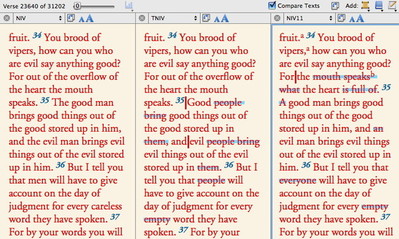Monday it was something old (the 400th anniversary of the KJV), yesterday it was something new (the release of the 2011 NIV), so it stands to reason that today we should talk about something “borrowed.” Yesterday I mentioned the fact that the publisher of the NIV wants to avoid selling competing revisions, so the 2011 edition is slated to be sold in place of both the 1984 NIV and the 2005 TNIV. Clearly, these two Bibles are living on “borrowed” time.
We are only permitted to continue selling the original NIV or the TNIV for a few short weeks, so if you want them you’ll need to act fast. The good news is that the 1984 NIV is today’s featured Bible in our Bible A Day Sale, so you can pick it up at a generous discount by getting today’s coupon code from our Twitter page.
Why would you want these earlier members of the NIV family if they’re being superseded by a new edition? One reason is so that you can compare the various editions and see what has changed. And since Accordance 9.3 has added the option to compare more than two texts at a time, you can have Accordance highlight the differences among all three editions.
As you can see from this example, the NIV11 renders Matthew 12:34 in more natural-sounding English than both the 1984 NIV and the TNIV. (Those earlier versions actually echo the rendering of the KJV, further attesting to the KJV’s ongoing influence.) In verses 35 and 36, the 1984 NIV uses the generic masculine throughout, while the TNIV tries to be more gender-inclusive by rendering singular nouns as plural. The NIV11 returns to using masculine nouns in verse 35, but uses “everyone” in place of “men” or “people” in verse 36.
Making these kinds of comparisons can help you see the distinctives of each revision, and can also alert you to aspects of the original Greek or Hebrew which may be worth exploring. Once again, if you want to make these kinds of comparisons with earlier editions, you’ll need to pick them up soon, because they’re living on borrowed time.


